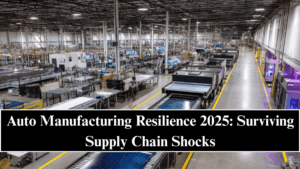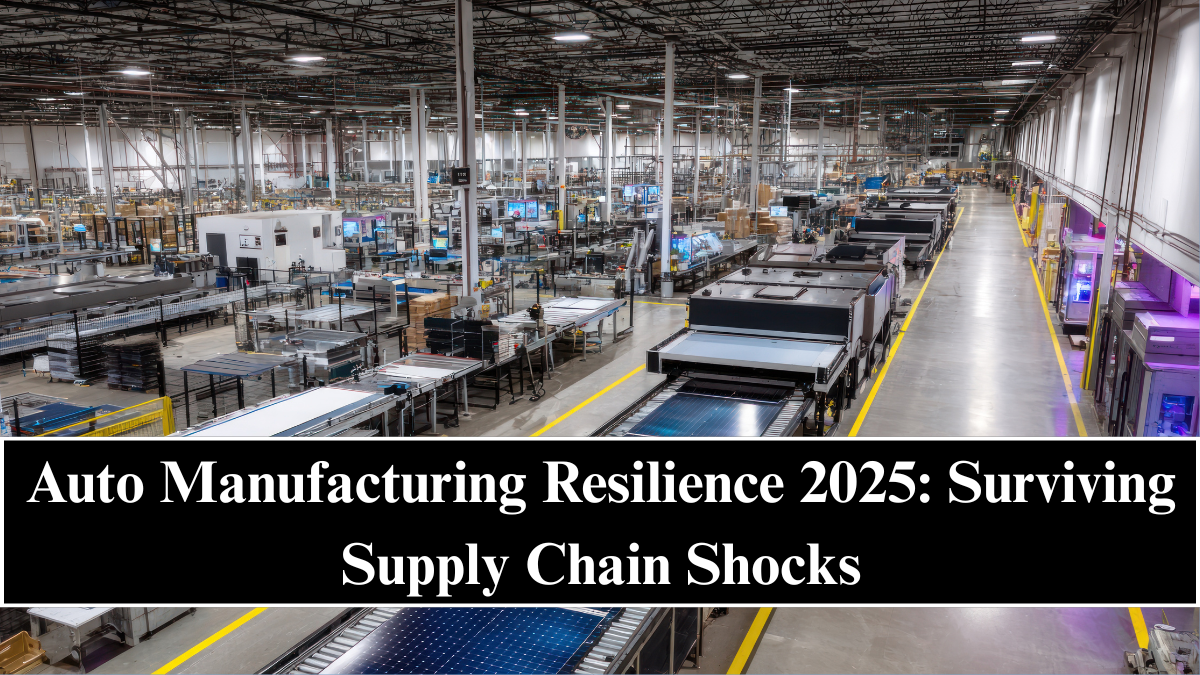The global automotive industry has learned some hard lessons since 2020 — from semiconductor shortages to logistics bottlenecks and raw material scarcity. In 2025, manufacturers are not just recovering but rebuilding smarter. The new era of auto manufacturing resilience focuses on local sourcing, supply chain transparency, and automation to safeguard against future crises.

The Post-Pandemic Shift in Global Auto Supply Chains
The pandemic exposed the fragility of a system heavily reliant on global interdependencies. When factories in Asia shut down, assembly lines in Europe and North America ground to a halt. Fast-forward to 2025, and the industry’s focus has shifted to building resilient, regionally diversified production networks.
Key changes include:
-
Localization of critical components such as semiconductors and batteries.
-
Vertical integration by automakers to control logistics and material sourcing.
-
AI-driven supply forecasting for real-time inventory adjustments.
-
Strategic stockpiling of essential raw materials like lithium and rare earths.
The goal is simple — no single disruption should bring production to a standstill again.
Regional Manufacturing Hubs: From Global to Glocal
In 2025, automakers are adopting a “glocal” (global + local) approach.
-
Europe is reshoring EV battery production through “Gigafactories” in Germany, Sweden, and France.
-
India is emerging as a cost-effective assembly hub with major investments from Hyundai, Tata, and Tesla.
-
North America has expanded local chip fabrication and steel recycling to reduce import dependency.
This localization trend is not only boosting resilience, but also cutting carbon footprints associated with long-distance transport — aligning with sustainability goals.
The Role of AI, Automation & Industry 4.0
Modern automotive factories in 2025 are powered by Industry 4.0 technologies — interconnected machines, real-time analytics, and predictive maintenance.
AI systems continuously monitor supplier performance, logistics routes, and risk indicators. If a component faces delay in Asia, the AI automatically redirects orders to alternate vendors in Europe or Mexico.
Automation now extends beyond assembly lines:
-
Collaborative robots (cobots) handle precision assembly alongside human technicians.
-
Digital twins simulate factory performance to prevent bottlenecks.
-
Blockchain-based tracking ensures full transparency from mining to finished vehicle delivery.
These advancements have turned factories into self-correcting ecosystems capable of adapting on the fly.
Sustainable Sourcing and Circular Manufacturing
Resilience in 2025 is not just about avoiding disruptions — it’s also about building sustainable production cycles. Automakers are adopting circular manufacturing, where old parts and batteries are recycled into new components.
Examples include:
-
Volvo using recycled aluminum and steel in 30% of its 2025 lineup.
-
Toyota implementing closed-loop recycling for hybrid battery materials.
-
Stellantis investing in raw material recovery plants for EV batteries in Italy and the U.S.
This reduces dependency on volatile resource markets while reinforcing long-term stability and cost efficiency.
Government Policies Supporting Manufacturing Resilience
Governments across the world are incentivizing local auto production to shield national economies from global shocks.
-
The U.S. Inflation Reduction Act (IRA) provides tax credits for EVs using domestically sourced batteries.
-
The EU’s Critical Raw Materials Act mandates supply chain transparency for key minerals.
-
India’s PLI (Production Linked Incentive) scheme has attracted billions in automotive component investment.
These policies ensure that manufacturing resilience is backed by both industry and government cooperation.
Challenges That Still Remain
While the sector has evolved, a few pain points persist:
-
High cost of localization for smaller suppliers.
-
Talent gaps in advanced manufacturing and robotics.
-
Cybersecurity threats targeting digital supply chains.
To counter this, companies are investing in workforce reskilling programs and AI-based security layers to keep their connected ecosystems safe and efficient.
The Future of Automotive Manufacturing Resilience
By late 2025, the auto industry is moving toward resilient-by-design ecosystems where supply chain visibility, digital automation, and sustainability converge.
Expect to see:
-
Zero-downtime factories through predictive analytics.
-
AI-powered risk modeling to forecast supply disruptions.
-
Decentralized manufacturing networks ensuring regional balance.
Resilience is no longer reactive — it’s built into the DNA of automotive production. The next disruption may come, but this time, the industry will be ready.
FAQs
What is auto manufacturing resilience?
It refers to the ability of automakers to withstand supply chain disruptions through local sourcing, digital monitoring, and flexible production systems.
Why did auto manufacturing need to change after 2020?
Global shortages — especially semiconductors — exposed how fragile supply chains were. Companies are now focusing on diversification and automation.
How is AI used in manufacturing resilience?
AI predicts potential delays, finds alternate suppliers, and monitors factory efficiency in real-time to prevent bottlenecks.
Which countries are leading in resilient auto manufacturing?
Germany, the U.S., Japan, and India have emerged as leaders due to investments in localized production and AI-driven logistics.
How does sustainability tie into manufacturing resilience?
Using recycled materials and renewable energy reduces environmental risk and long-term dependency on limited raw resources.
Click here to know more.
